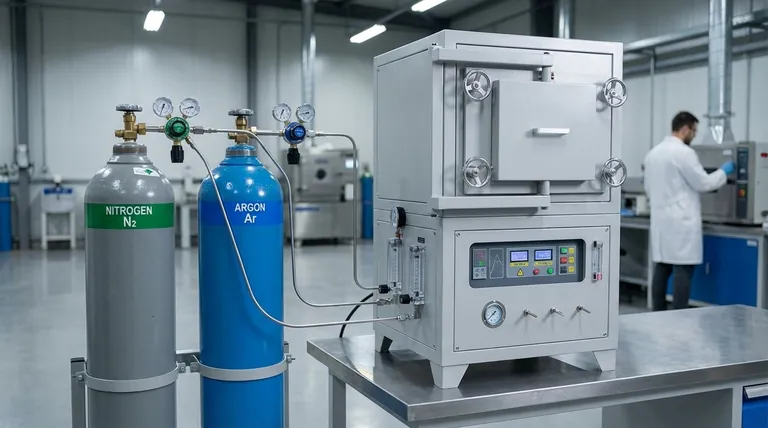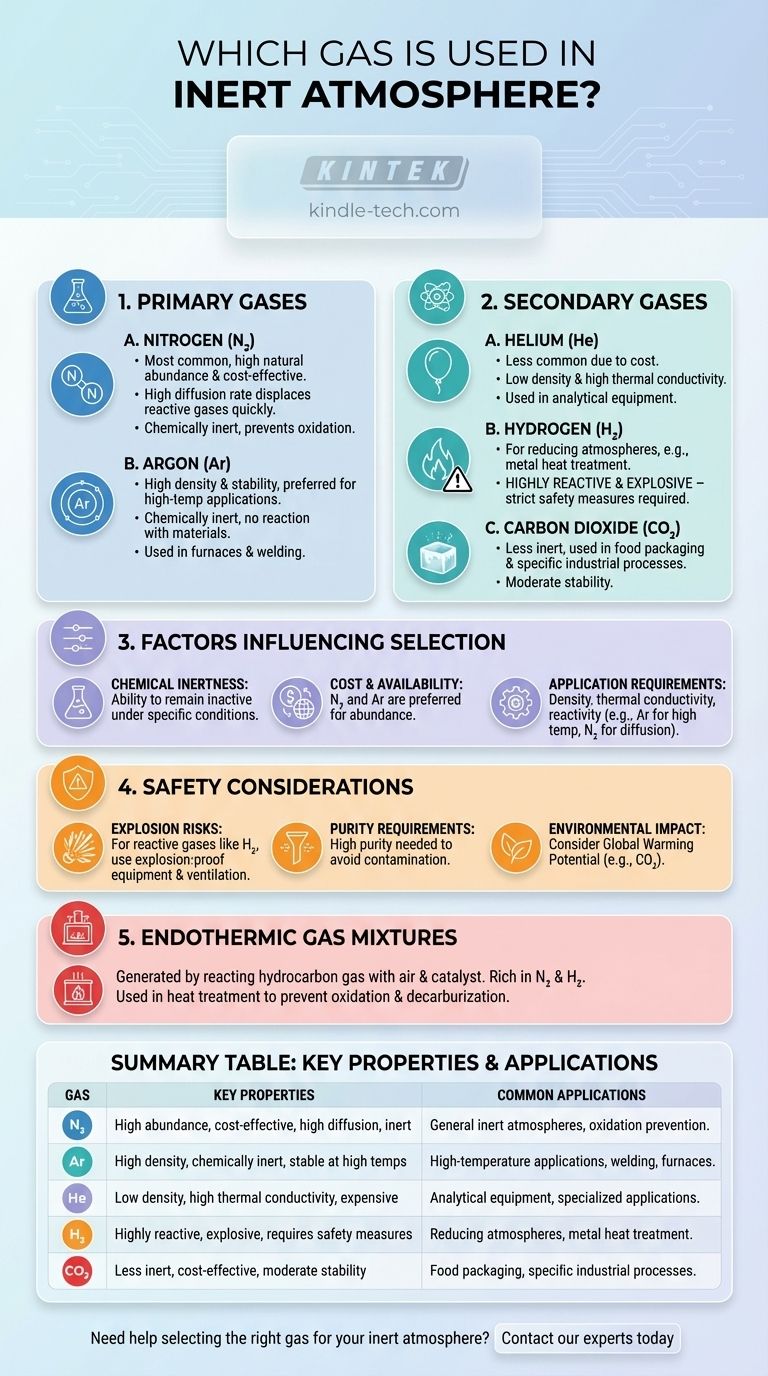Inert atmospheres are used to create a non-reactive environment, often in industrial or laboratory settings, to prevent unwanted chemical reactions such as oxidation or contamination. The most commonly used gases for this purpose are nitrogen and argon due to their high natural abundance and chemically inert properties. Nitrogen is particularly favored for its high diffusion rate, while argon is valued for its density and stability. Other gases like helium, hydrogen, and carbon dioxide may also be used depending on specific application requirements. Safety considerations, such as explosion-proof measures, are essential when using reactive gases like hydrogen.

Key Points Explained:
-
Primary Gases Used in Inert Atmospheres:
-
Nitrogen (N2):
- Nitrogen is the most commonly used gas for creating inert atmospheres due to its high natural abundance and cost-effectiveness.
- It has a high diffusion rate, which allows it to quickly displace oxygen and other reactive gases.
- Nitrogen is chemically inert under most conditions, making it ideal for preventing oxidation and other unwanted reactions.
-
Argon (Ar):
- Argon is another widely used gas for inert atmospheres, particularly in applications requiring higher density or stability.
- It is chemically inert and does not react with most materials, even at high temperatures.
- Argon is often used in specialized applications, such as in furnaces or welding, where its density provides better protection against contamination.
-
Nitrogen (N2):
-
Secondary Gases and Their Applications:
-
Helium (He):
- Helium is less commonly used due to its higher cost and lower natural abundance.
- It is used in specific applications where its low density and high thermal conductivity are advantageous, such as in certain types of analytical equipment.
-
Hydrogen (H2):
- Hydrogen is used in specific applications where reducing atmospheres are required, such as in metal heat treatment.
- However, hydrogen is highly reactive and explosive, necessitating strict safety measures, including explosion-proof equipment and controlled environments.
-
Carbon Dioxide (CO2):
- Carbon dioxide is sometimes used in inert atmospheres, particularly in food packaging and certain industrial processes.
- It is less inert than nitrogen or argon but can be effective in specific applications where its properties are beneficial.
-
Helium (He):
-
Factors Influencing Gas Selection:
- Chemical Inertness: The primary requirement for a gas used in an inert atmosphere is its ability to remain chemically inactive under the given conditions.
- Cost and Availability: Nitrogen and argon are preferred due to their high natural abundance and relatively low cost.
- Application-Specific Requirements: The choice of gas may depend on specific needs such as density, thermal conductivity, or reactivity. For example, argon is preferred in high-temperature applications due to its stability, while nitrogen is favored for its rapid diffusion.
-
Safety Considerations:
- Explosion Risks: When using reactive gases like hydrogen, it is crucial to implement safety measures to prevent explosions. This includes using explosion-proof equipment and ensuring proper ventilation.
- Purity Requirements: The gases used must be of high purity to avoid introducing contaminants that could react with the materials being protected.
- Environmental Impact: The choice of gas may also consider environmental factors, such as the global warming potential of gases like carbon dioxide.
-
Endothermic Gas Mixtures:
- In some cases, endothermic gas mixtures are used to create inert atmospheres. These mixtures are generated by reacting a hydrocarbon gas with air in the presence of a catalyst, producing a gas mixture that is rich in nitrogen and hydrogen.
- These mixtures are often used in heat treatment processes to prevent oxidation and decarburization of metals.
By understanding these key points, a purchaser can make informed decisions about which gas to use for creating an inert atmosphere, based on the specific requirements of their application, cost considerations, and safety protocols.
Summary Table:
| Gas | Key Properties | Common Applications |
|---|---|---|
| Nitrogen | High natural abundance, cost-effective, high diffusion rate, chemically inert | General inert atmospheres, oxidation prevention |
| Argon | High density, chemically inert, stable at high temperatures | High-temperature applications, welding, furnaces |
| Helium | Low density, high thermal conductivity, expensive | Analytical equipment, specialized applications |
| Hydrogen | Highly reactive, explosive, requires safety measures | Reducing atmospheres, metal heat treatment |
| CO2 | Less inert, cost-effective, moderate stability | Food packaging, specific industrial processes |
Need help selecting the right gas for your inert atmosphere? Contact our experts today for personalized guidance!
Visual Guide

Related Products
- 1200℃ Controlled Atmosphere Furnace Nitrogen Inert Atmosphere Furnace
- 1700℃ Controlled Atmosphere Furnace Nitrogen Inert Atmosphere Furnace
- 1400℃ Controlled Atmosphere Furnace with Nitrogen and Inert Atmosphere
- Controlled Nitrogen Inert Hydrogen Atmosphere Furnace
- 1700℃ Laboratory Quartz Tube Furnace with Alumina Tube Tubular Furnace
People Also Ask
- What is meant by inert atmosphere? A Guide to Preventing Oxidation & Ensuring Safety
- What is an example of an inert atmosphere? Discover the Best Gas for Your Process
- What is an inert atmosphere heat treatment? Protect Your Metals from Oxidation & Decarburization
- What provides an inert atmosphere? Achieve Safety and Purity with Nitrogen, Argon, or CO2
- Can nitrogen gas be heated? Leverage Inert Heat for Precision and Safety



















